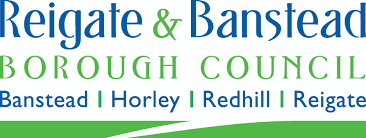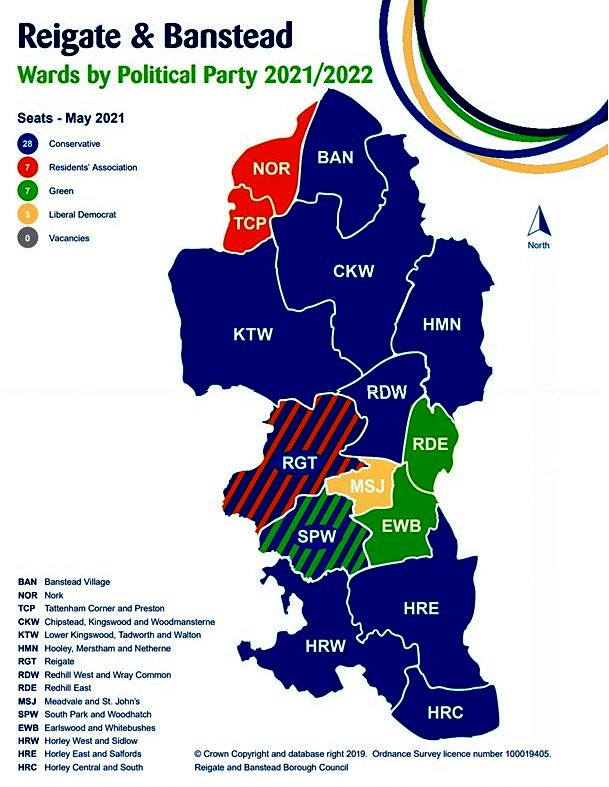As residents living in the Tattenham & Preston Ward we elect councillors to serve on Reigate & Banstead Borough Council and Surrey County Council. This is the first of two articles explaining how these organisations work and what our local councillors do. In this article we are going to look at our Borough Council.

What does Reigate & Banstead Borough Council Do?
The key responsibilities of the Borough Council include:
• Refuse collection
• Street cleaning and litter collection
• Grass cutting and maintenance of green areas
• Car parking and parking enforcement
• Parks and leisure centres
• Planning and building regulations
• Housing (via Housing Associations) and Housing Benefits
• Licencing of bars and restaurants and taxis and private hire vehicles
• Day centres
• Local business development and support
• Local environmental issues
It is also responsible for collecting Council Tax from every property in the Borough including the tax due to Surrey County Council and Surrey Police.
It is also responsible for collecting Council Tax from every property in the Borough including the tax due to Surrey County Council and Surrey Police.
Who runs the Council?
Whilst the work of the Council is conducted by an employed workforce (of just over 500), the business strategy and key decisions are the responsibility of an elected group of 45 Borough Councillors.
The role of councillors is to decide how the Council should carry out its various activities, and to represent the interests of voters in their ward (local area) as well as the general public interest. This is achieved by participating in council and committee meetings, maintaining contact with residents through local surgeries, being available to learn about and address local issues raised by residents, and general involvement in the community. Local councillors are often school governors and members of local resident associations and other community committees.
They are not paid for their work but receive a taxable allowance to help fund their time and general expenses. Currently Reigate & Banstead councillors receive an allowance of £5670 per year, which is set by an independent remuneration panel.
The Chief Executive, the Chief Finance Officer and the Legal Officer are appointed by the Council and are responsible for the delivery of services.
The Council meets at the Town Hall in Reigate.
How is the Council organised?
Following an election, the 45 councillors elect a Leader. In cases such as ours where one political party holds a clear majority, the leader of the largest political group (Conservatives), is elected.
The Leader then appoints an Executive which, in Reigate & Banstead, consists of a Deputy Leader and eight Portfolio Holders who take responsibility for a particular aspect of the Council’s work. For example, the Portfolio Holder for Neighbourhood Services is responsible for licencing, parking, waste & recycling, greenspaces, and fleet & cleansing.
This is not dissimilar to Central Government where the majority party appoints a Prime Minister who then selects a Cabinet to manage the key functions of government.
The Borough Council’s Executive meets every six weeks to discuss and agree the major policy decisions of the Council.
The remainder of Councillors serve on one or more Ordinary Committees which meet every four weeks to review and agree the day-to-day work of the Council. Reigate & Banstead has six ordinary committees and an Overview & Scrutiny Committee. This important committee examines whether Council services and policies are being delivered in the most efficient and effective way possible, and whether they are meeting the needs of local residents, businesses, and users of Council services. It monitors the annual budget and month by month expenditure.
The other major committee is the Planning Committee – which comprise 15 councillors who decide on all applications for two or more new dwellings. Household extensions are generally decided by the Planning Department Officers. We will explain more on planning in a future issue.
All councillors also attend full Council Meetings around six times a year. These provide an opportunity for councillors to question members of the Executive and for members of the public to raise questions. All these formal meetings are usually open to the public, more recently online.
Full Council meetings are chaired by the Mayor, who is elected from and by Councillors each year. The mayor is the first citizen of the Borough and, in addition to chairing the Council represents, the Borough by attending formal functions and events.
Councillors are also available in their local ward to meet constituents to discuss their issues, answer their questions, and if necessary, raise such matters with Council departments or the Council itself.
How are Councillors elected?
The Borough is split into 15 wards, the residents of which elect three Councillors to serve on the Council. A councillor serves for four years, and elections are usually held on the first Thursday in May for one position per ward per year.

Anyone can put themselves forward for election provided they are over 18 and nominated by ten residents living in the ward and registered on the electoral roll. To be eligible to vote a resident must be over 18 and register via the Council’s Annual Electoral Canvass.
The candidate who polls the most votes in the ward elections is elected as a Councillor.
In most cases, councillors are members of one of the national political parties and are nominated by their party. But they can stand as independents, often as residents association candidates.
The three Tattenham & Preston councillors are Tim Snuggs, Barry Nash and Nick Harrison. All have been nominated by and represent the Tattenham & Preston Residents Association.
How is the Council financed?
The Council’s net budget (proposed expenditure) for 2020/21 was £18 million, after taking into account income from Council activities such as parking charges, planning application fees and licencing charges. This net budget was funded from Council Tax (£14 million), Business Rates (£3 million), a central government grant of £0.6 million for homelessness prevention, with £1 million being drawn from reserves.
Reigate & Banstead is one of a small number of councils in the South-East which receives no Revenue Support Grant at all from central government, in contrast to London, other cities and more rural areas.
The Council Tax Rate is decided every year based on the Council’s budget. Whereas income tax is an individual tax calculated on income earned, Council Tax is levied on every domestic property in the Borough and varies according to the value of a property.
There is a range of eight bands ranging from an annual tax of £1381.41 for Band A properties to £4144.22 for Band H. Band D is considered the average band in the Borough and the current rate is £2072.11 for the year. The bandings are set by HM Revenue & Customs.
However only a small proportion of this sum goes to the Borough Council. From Band D only £237.46 (12%) goes towards local council services. The remainder goes to Surrey County Council (£1549.08 – 74%) and Surrey Police (£285.56 – 14%).
It should be noted that the Council collects £52 million in Business Rates but retains only £3 million. £5 million goes to the County Council, and the remaining £44 million goes to Central Government for use elsewhere in the country.
In the next article we will cover the role of Surrey County Council and its councillors.
